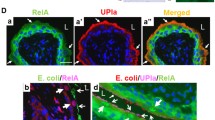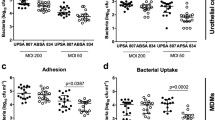Abstract
Uroepithelial defense has been suggested to contribute to the local host resistance against ascending urinary tract infection. The cellular mechanism, however, is not known. In this study, bacterial growth was measured under the direct and indirect influence of uroepithelial cells. To study if a specific ligand-receptor interaction is required for uroepithelial cell (UEC) activation, isogenic Escherichia coli mutants expressing either mannose-sensitive, mannose-resistant (p), or mannose resistant (s) pili were tested for their capacity to induce the UEC defense mechanism. The antibacterial effect of UEC was abolished either by performing coculture in chambers with a fluid-permeable membrane which separates UEC from bacteria or by inhibiting membrane contact using the antiadherence factor pentosane polysulfate. No difference between the various types of pili could be shown. All E. coli strains adherened comparably to the UEC and were subsequently suppressed in their growth. Even a “naked” mutant without expression of common pili showed a similar behavior. In conclusion, bacterial growth suppression depends on direct contact between the UEC and bacteria, but is independent of common pili expressed on E. coli.
Similar content being viewed by others
References
Johnson JR (1991) Virulence factors in Escherichia coli urinary tract infection. Clin Microbiol Rev 4: 80–128
Sandberg T, Kaiser B, Lidin-Janson G, Lincoln K, Orskov F, Orskov I, Stokland E, Svanborg-Eden C (1988) Virulence of Escherichia coli in relation to host factors in women with symptomatic urinary tract infection. J Clin Microbiol 26: 1471–1476
Stull TL, LiPuma JJ (1991) Epidemiology and natural history of urinary tract infections in children. Med Clin North Am 75: 287–297
Svanborg-Eden C, Gotschlich EC, Korhonen TK, Leffler H, Schoolnik G (1983) Aspects on structure and function of pili on uropathogenic Escherichia coli. Prog Allergy 33: 189–202
Svanborg-Eden C, Man P de, Jodal U, Linder H, Lomberg H (1987) Host-parasite interaction in urinary tract infection. Pediatr Nephrol 4: 623–631
Lynn WA, Golenbock DT (1992) Lipopolysaccharide antagonists. Immunol Today 13: 271–276
Moch T, Hoschützky H, Hacker J, Kröncke K-D, Jann K (1987) Isolation and characterization of the alpha-sialyl-beta-2,3-galactosyl-specific adhesion from fimbriated Escherichia coli. Proc Natl Acad Sci USA 84: 3462–3466
Svanborg-Eden C, Jodal U (1979) Attachment of Escherichia coli to urinary sediment epithelial cells from urinary tract infection-prone and healthy children. Infect Immun 26: 837–840
Svanborg-Eden C, Hagberg L, Hanson LA, Hull S, Hull R, Jodal U, Leffler H, Lomberg H, Straube E (1983) Bacterial adherence — a pathogenic mechanism in urinary tract infections caused by Escherichia coli. Prog Allergy 33: 175–188
Kröncke K-D, Orskov F, Jann B, Jann K (1990) Electron microscopic study of coexpression of adhesive protein capsules and polysaccharide capsules in Escherichia coli. Infect Immun 58: 2710–2714
Robledo JA, Serrano A, Domingue GJ (1990) Outer membrane proteins of E. coli in the host-pathogen interaction in urinary tract infection. J Urol 2: 386–391
Leffler H, Svanborg-Eden C (1981) Glycolipid receptors for uropathogenic Escherichia coli on human erythrocytes and uroepithelial cells. Infect Immun 43: 920–929
Cox CE, Hinman F (1961) Experiments with induced bacteriuria, vesical emptying and bacterial growth on the mechanism of bladder defense to infection. J Urol 86: 739–743
Mannhardt W, Schofer O, Schulte-Wissermann H (1986) Pathogenic factors in recurrent urinary tract infections and renal scar formation in children. Eur J Pediatr 145: 330–336
Parsons CL (1986) Pathogenesis of urinary tract infections. Bacterial adherence, bladder defense mechanisms. Urol Clin North Am 13: 563–567
Parsons CL, Stauffer CW, Schmidt JD (1988) Reversible inactivation of bladder surface glycosaminoglycan antibacterial activity by protamine sulfate. Infect Immun 56: 1341–1343
Ruggieri MR, Levin RM, Hanno PM, Witkowski BA, Gill HS, Steinhardt GF (1988) Defective antiadherence activity of bladder extracts from patients with recurrent urinary tract infection. J Urol 140: 157–159
Schaeffer AJ (1988) Pathogenesis of recurrent urinary tract infection: use of understanding as therapy. Urology [Suppl] 32: 13–15
Schaeffer AJ (1990) Modifiers of susceptibility to urinary tract infection. J Urol 143: 138
Bollgren I, Winberg J (1976) The periurethral aerobic flora in girls highly susceptible to urinary tract infections. Acta Paediatr Scand 65: 81–87
Stamey TA, Mihara G (1976) Studies of introital colonization in women with recurrent urinary tract infection. VI. Analysis of segmented leukocytes in the vaginal vestibule in relation to enterobacterial colonization. J Urol 116: 72–73
Schulte-Wissermann H, Mannhardt W, Scharz J, Zepp F, Bitter-Suermann D (1985) Comparison of the antibacterial effect of uroepithelial cells from healthy donors and children with asymptomatic bacteriuria. Eur J Pediatr 144: 230–233
Schofer O, Ludwig KH, Mannhardt W, Beetz R, Zepp F, Schulte-Wissermann H (1988) Antibacterial capacity of buccal epithelial cells from healthy donors and children with recurrent urinary tract infections. Eur J Pediatr 147: 229–232
Hacker J, Schmidt G, Hughes C, Knapp S, Marget M, Goebel W (1985) Cloning and characterization of genes involved in production of mannose-resistant, neuraminidase-susceptible (X) fimbriae from an uropathogenic 06:K15:H31 Escherichia coli strain. Infect Immun 2: 434–440
Martin X, Werness PG, Bergert JH, Smith LH (1984) Pentosane polysulphate as an inhibitor of calcium oxalate crystal growth. J Urol 132: 786–788
Orskov I, Ference A, Orskov F (1980) Tamm Horsfall protein or uromucoid is the normal urinary slime that traps type I fimbriated Escherichia coli. Lancet I: 887
Steadman R, Topley N, Jenner DE, Davies M, Williams JD (1988) Type 1 fimbriate Escherichia coli stimulates a unique pattern of degranulation by human polymorphonuclear leukocytes. Infect Immun 56: 815–822
Lei M-G, Morrison DC (1988) Specific endotoxic lipopoly-saccharide-binding proteins on murine splenocyte. I. Detection of lipopolysaccharide-binding sites on splenocytes and splenocyte subpopulations. J Immunol 141: 996–1005
Svanborg C, Agace W, Hedges S, Lindstedt R, Svensson ML (1994) Bacterial adherence and mucosal cytokine production. Ann NY Acad Sci 730: 162–181
Mannhardt W, Putzer M, Zepp F, Schulte-Wissermann H (1995) Host defense within the urinary tract. II. Cell-bacteria interaction activates the uroepithelial defense mechanism via signal transduction. Pediatr Nephrol (in press)
Author information
Authors and Affiliations
Rights and permissions
About this article
Cite this article
Mannhardt, W., Becker, A., Putzer, M. et al. Host defense within the urinary tract. I. Bacterial adhesion initiates an uroepithelial defense mechanism. Pediatr Nephrol 10, 568–572 (1996). https://doi.org/10.1007/s004670050162
Received:
Revised:
Accepted:
Issue Date:
DOI: https://doi.org/10.1007/s004670050162




